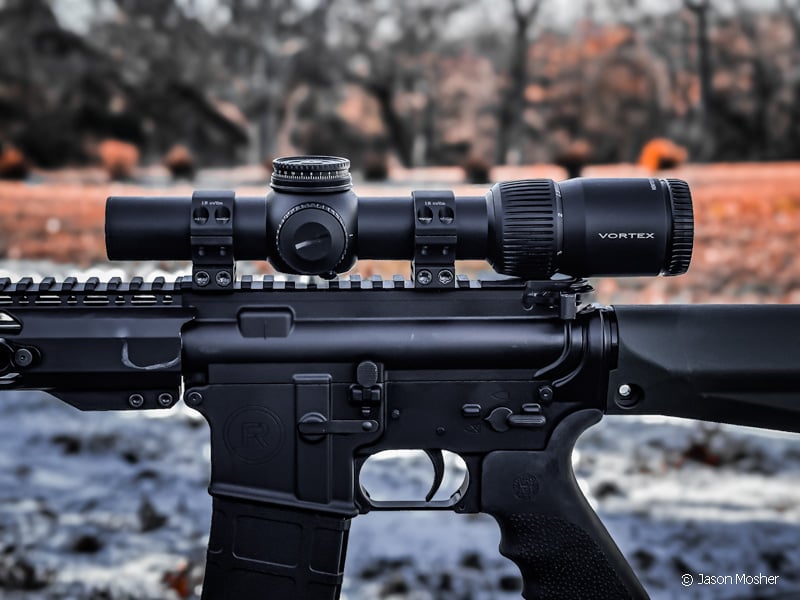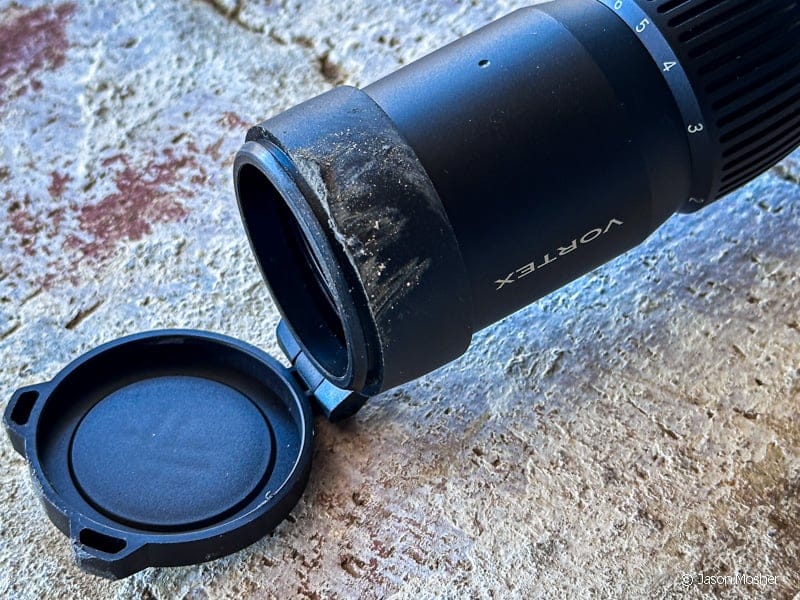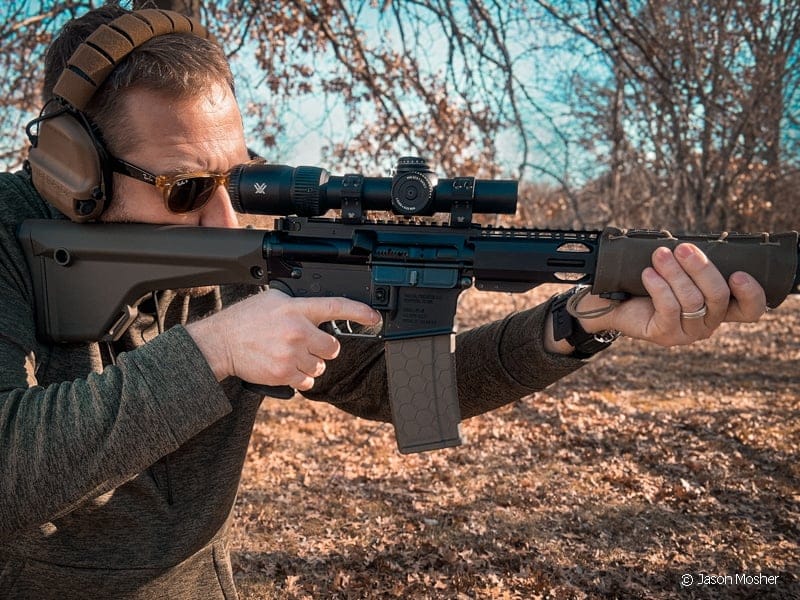Vortex has released their new LPVO by way of the Venom SFP 1-6×24. It uses an AR-BDC3 illuminated reticle to make sure you can see where you are aiming any time of the day or night. The Vortex Venom LPVO has some great features. It has true 1x magnification with the ability to hit and stay on target. The red illuminated reticle is easy to see and keep adjusted. Vortex also added an “off” position between each brightness setting, another feature I like. This allows you to go straight to the illumination you want with one turn of the dial.

Vortex Venom LPVO
From my time with the Venom, this appears to be a great quality optic for the price. Made from aircraft grade aluminum, the low-glare matte black anodized 30mm tube is gas-purged and O-ring sealed. According to the company, the Venom can withstand the “highest levels of impact.” I like testing optics so I put this one through the ringer, which I’ll talk more about below. Adjustment turrets are ¼ MOA increments with 25 MOA travel per rotation. After removing the caps, you can easily turn the turrets by hand, so no tools needed to zero it.

Testing the Vortex Venom LPVO
Like I do with most other optics, I test them to see if what the manufacturer puts on the box is accurate. According to Vortex, the Venom is water rated for IPX 7 with an operating temperature between -4 to 140°F. A durable optic should withstand any daily abuse from being mounted to a rifle. Because of this, I try to keep my testing realistic instead of seeing what crazy things I could do before it breaks. Not that other tests are uninteresting or bad, but I want to simulate what I call “normal” abuse.
Water Test
For this series of tests, I started with water. I didn’t do a complete IPX7 test, but I did drop it in the bathtub for 30 minutes. The point is to demonstrate it will survive dropping my gun in water, not taking it for a swim. After 30 minutes, I dried the Venom off and inspected it. From what I can tell, the turret covers kept water out of the turrets. I took the battery cover off and didn’t find any moisture around the battery. There was no water in the tube and everything appeared to be functioning properly.
Freeze and Heat Tests
I then placed the optic in my freezer and left it overnight. My freezer is set to 6°F; so not quite as cold as the rating, but close enough. It warmed up some before I got it mounted and out to shoot, but I couldn’t tell any difference on the range. After that, I placed the Venom on a cookie sheet and left it in the oven until the surface temperature on the optic was over 140°F. I decided to leave it longer to make sure the interior components were hot as well.

Drop Test
Again, I don’t go to the extreme with most products I review. I want to see how this optic holds up to impact from a distance I would accidentally drop it from. For this, I held the optic shoulder height out to my side and dropped it onto several surfaces. I started with the wood floor in my house and dropped it twice. This didn’t even scratch it, so I headed outside for a harder surface.

Why an LPVO?
When low power variable optics (LPVOs) first came out, they appeared to be the future of the optics world. But after a while, people started going back to red dots or using flip-to-side magnifiers. Currently though, the US Marine Corps has started using LPVOs as standard issue. They call it the SCO (squad common optic) or, to the rest of us, the Trijicon VCOG. People take note of what the military is doing because the military tests and uses more firearms and equipment than anyone else.

On the Range With the Vortex Venom LPVO
I have the Venom mounted to an AR-15 shooting 55 grain 5.56 PMC X-Tac ammunition. For sight-in, I started with a bore sight at 20 yards. After that, I moved to 50 yards and sighted the LPVO in with about four shots. From there, I kept a good group out to 100 yards. Despite multiple removals for testing, the Venom was less than one inch off from where it started. With one click of the elevation turret, it was zeroed.

What are my thoughts?
I like the Venom riflescope. Before LPVOs, one had to choose an optic for CQB or long distance. This LPVO is a perfect solution for both and retails for $299, which is a heck of a deal. It feels solid, the XD glass is crystal clear, and the red illumination helps for both day and night use. This optic would be perfect on an AR-15 for self-defense or even hunting. This could easily be the best LPVO on the market in this price range. Matching the quality with a different brand would require spending much more money.
Any time I write about Vortex, I also have to mention their customer service. I think this is just as important to others as well. A company is only as good as their customer service and Vortex is among the best I’ve encountered. When doing reviews, I call them on a regular basis. There is no special phone number or contact for me to call and I don’t get their product from them. Instead, I call the same number as every other customer (1-800-486-7839) and someone answers very quickly. I also email them at [email protected] and receive a reply the same day or even within the hour.
Vortex offers an unconditional lifetime warranty on all their products regardless of when or where you got it. If something is wrong, they will make it right. Unfortunately, this type of customer service is becoming rare. They make great products at an affordable price, but it’s their warranty and customer service that really set them apart. If you are looking for a new optic, make sure you check out the new Venom SFP 1-6×24 riflescope, currently available at GMW for $299.99.


